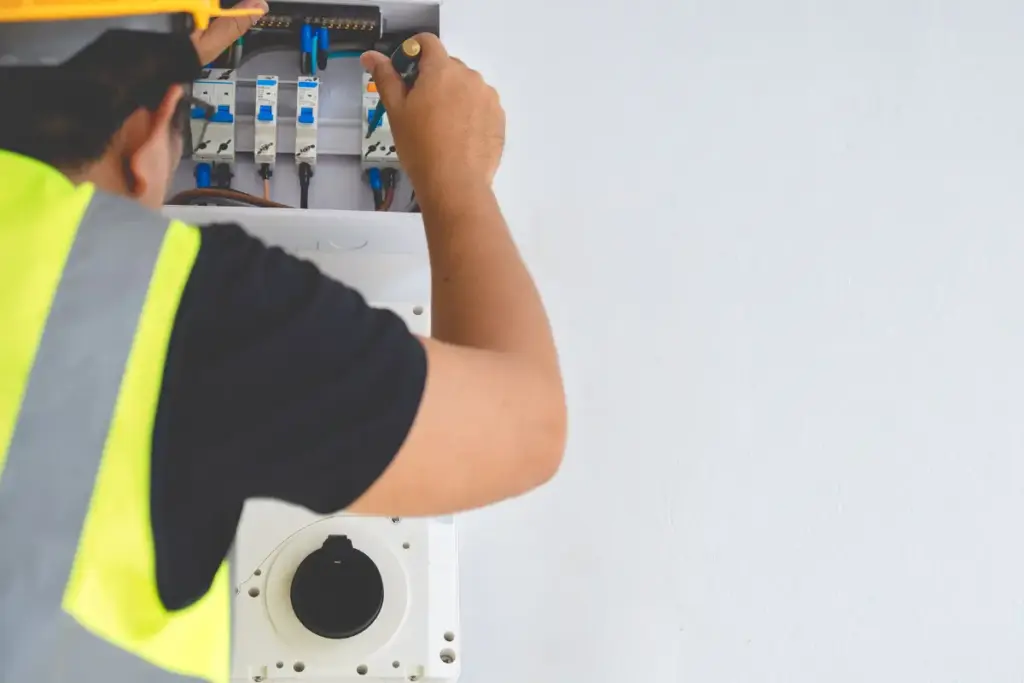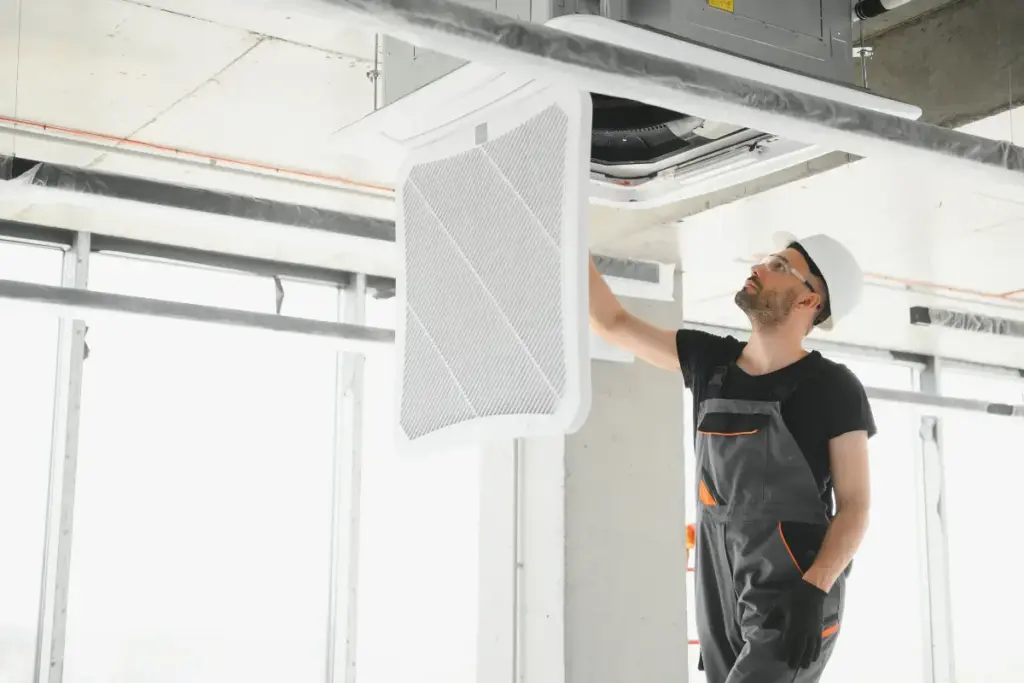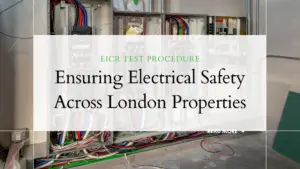The EICR code for No AFDD in HMO properties flags a concerning absence of Arc Fault Detection Devices, which are essential for preventing electrical fires by detecting and isolating arc faults. This code generally results in a C3 classification, suggesting that AFDD installation is recommended, though not mandatory under current standards. In HMOs, where high occupancy and varied device usage elevate electrical fire risks, the incorporation of AFDDs is vital to enhance safety. Addressing the lack of AFDDs not only mitigates immediate fire hazards but also prepares properties for potential future regulations. Continued exploration will uncover further insights on safeguarding HMOs against electrical risks.
Table of Contents
ToggleKey Takeaways
- “No AFDD” in an EICR usually results in a C3 code, suggesting that AFDD installation is recommended for enhanced safety.
- AFDDs prevent electrical fires by detecting and disconnecting power during dangerous arc faults, crucial in densely occupied HMOs.
- In HMOs, high tenant turnover and diverse appliance use increase the importance of AFDDs for preventing arc-related fire risks.
- Without AFDDs, HMO properties may face higher electrical safety risks, emphasising the need for landlords to consider upgrades.
- Proactive installation of AFDDs can improve HMO safety standards, attract better tenants, and reduce insurance costs.
What Does “No AFDD” Mean in an EICR Report?
In an Electrical Installation Condition Report (EICR), the notation “No AFDD” indicates that Arc Fault Detection Devices are not present in the electrical system. This code is essential for property owners and safety inspectors to identify areas where enhancements might be needed to improve electrical safety.
An EICR assesses the safety of an electrical installation, probing for any defects or deviations from the wiring regulations that might pose safety risks. The absence of AFDDs, which are designed to protect against arc-fault-caused fires in circuits, suggests a potential vulnerability in the property’s electrical infrastructure.
Arc faults can occur due to damaged wires, loose connections, or deteriorated insulation, and they are known for initiating electrical fires. While not currently mandated across all property types, the inclusion of AFDDs in electrical systems is increasingly viewed as a prudent measure in modern electrical safety practices.
Understanding what “no AFDD” means on an EICR report in the UK helps property owners interpret electrical safety findings accurately.
Why AFDDs are Important for Electrical Safety in HMOs
With multiple residents often using various electrical devices simultaneously, the risk of electrical fires increases substantially. Arc Fault Detection Devices (AFDDs) are designed to mitigate these risks by identifying and disconnecting arcing faults, which are often precursors to electrical fires.
The importance of AFDDs in HMO electrical safety lies in their ability to detect dangerous arc faults and prevent electrical fires.
Each tenant’s different electrical appliances can introduce new, unforeseen hazards, escalating the potential for dangerous arc faults. Traditional circuit protection methods like circuit breakers and fuses may not respond quickly enough to these arc faults, especially if they are low-level and continuous, which are common in high-electrical-use environments.

Which EICR Code Applies When No AFDD is Installed?
Knowing that applying which EICR code for no AFDD in HMO properties helps landlords determine whether the issue is advisory or requires immediate attention.
Currently, the regulations do not universally mandate the installation of AFDDs in existing HMO properties. As a result, the non-existence of AFDDs alone does not automatically warrant a failing code, such as C1 (Danger present) or C2 (Potentially dangerous).
Instead, the typical classification might fall under the C3 code, which indicates that improvement is recommended. This code suggests that while the electrical system is generally safe, installing AFDDs could enhance safety by reducing the risk of electrical fires from arc faults.
Electrical inspectors need to assess the overall condition of the electrical installation and consider factors such as the age of the system, the complexity of the circuitry, and the presence of other protective devices before assigning an EICR code.
This ensures a balanced, informed approach to enhancing electrical safety in HMOs.
How AFDDs Work to Prevent Electrical Fires
AFDDs are advanced safety devices designed to protect electrical circuits from arc faults, which can lead to electrical fires. An arc fault is an arc created by current flowing through an unplanned path. These arcs can generate high temperatures, igniting nearby flammable materials.
AFDDs monitor the electrical network for occurrences of arc-like patterns. They differentiate between harmless arcs, such as those created when a switch is turned on, and potentially dangerous arcs that suggest a fault in the circuitry. Upon detecting a dangerous arc, the AFDD quickly disconnects the power supply, mitigating the risk of fire.
| Feature | Functionality |
| Detection Method | Monitors electrical waveforms for arcs. |
| Response Time | Disconnects power rapidly upon detection. |
| Discrimination | Differentiates between safe and unsafe arcs. |
This technology not only provides a critical safety measure but also offers peace of mind, knowing that hidden electrical faults can be addressed before they cause damage.
When Did AFDD Requirements Become Part of UK Wiring Regulations
Several years ago, specific requirements for the implementation of Arc Fault Detection Devices (AFDDs) were introduced into the UK Wiring Regulations. This significant change occurred with the release of the 18th Edition of the Wiring Regulations, which came into effect in January 2019.
The regulations, formally known as (BS 7671:2018+A2:2022), set new standards to enhance electrical safety and reduce the risk of arc-fault-caused electrical fires.
The inclusion of AFDDs in the regulations marked a proactive step toward addressing the complexities of modern electrical loads and the hazards they pose to residential and commercial buildings.
The 18th Edition specifically recommends the use of AFDDs in AC final circuits of a fixed installation with a rated voltage not exceeding 230 volts in single-phase installations, where the circuit supplies sockets or fixed current-using equipment.
Learning when AFDDs were added to UK wiring regulations clarifies why newer installations may now require this level of fire protection.
Why Some EICR Reports Highlight the Absence of AFDDs
In Electrical Installation Condition Reports (EICR), the absence of Arc Fault Detection Devices (AFDDs) is often highlighted due to their significant role in enhancing fire safety within premises.
Identifying these devices in EICR is essential because arc faults can occur in electrical circuits that appear to be in good working order. These faults are often concealed within walls or in complex appliance circuits, making them difficult to detect without specialised technology.
Understanding why EICR reports mention no AFDD installed helps landlords see that it’s often a recommendation rather than a fault code. It informs property owners of potential risks that are not immediately visible but could have severe consequences.
This aspect of the report is particularly significant in Houses in Multiple Occupation (HMOs), where the risk and potential impact of electrical fires are elevated due to the greater number of occupants and increased use of electrical devices.
What Action Should You Take After Receiving a “No AFDD” EICR Code?
Upon receiving a “No AFDD” code in your Electrical Installation Condition Report (EICR) for an HMO property, immediate action is recommended to address this safety concern. This code indicates a lack of Arc Fault Detection Devices (AFDDs), which are essential for preventing electrical fires. The absence of AFDDs does not immediately imply non-compliance with current regulations but highlights a potential safety upgrade.
Here are the steps you should consider:
| Step | Action | Outcome |
| 1 | Review the EICR | Understand the specifics of the electrical safety recommendations. |
| 2 | Consult a Qualified Electrician | Get professional advice on the necessity and feasibility of installing AFDDs. |
| 3 | Assess Financial Implications | Consider the cost of installation against the potential risk reduction. |
| 4 | Schedule Installation | Plan for minimal disruption to occupants. |
| 5 | Follow-up Inspection | Verify the installation complies with electrical safety standards. |
This table will help visualise the process, from understanding the implications of the “No AFDD” code to confirming compliance and enhancing safety. Each step is designed to systematically resolve the identified risk and safeguard the safety of all occupants in the HMO property.
How to Upgrade an HMO Electrical System to Include AFDDs
Upgrading the electrical system in an HMO to include Arc Fault Detection Devices (AFDDs) is a critical step to enhance tenant safety and minimise the risk of electrical fires.
Here’s how to proceed with this upgrade:
- Assessment: Begin by consulting a qualified electrician who can assess the current electrical system’s capacity and compatibility with AFDDs.
This assessment will determine the necessary modifications or additions to the existing electrical panels.
- Planning: Based on the assessment, the electrician will design a plan for integrating AFDDs.
This plan should include the placement of AFDDs within the circuit layout to cover all critical areas effectively.
- Installation: The installation should comply with the latest wiring regulations and standards specific to HMO properties.
It involves replacing or augmenting the existing circuit breakers with AFDDs. Verify that each AFDD is correctly installed to monitor its designated circuit.
- Testing and Verification: After installation, the system must be thoroughly tested to confirm that all AFDDs are functioning correctly and providing the necessary protection.
- Documentation: Update your Electrical Installation Condition Report (EICR) to reflect the new installations and verify compliance with local regulations.
This upgrade not only enhances safety but also reduces insurance premiums by lowering risk profiles.

What Landlords Need to Know About AFDD Recommendations in EICR Reports
Landlords must understand the implications of AFDD recommendations in Electrical Installation Condition Reports (EICR) to guarantee compliance and safety in their HMO properties. When an EICR includes recommendations to install AFDDs (Arc Fault Detection Devices), it indicates a concern about preventing electrical fires caused by arc faults in electrical circuits.
Understanding AFDD recommendations involves recognising several key points:
- Safety Enhancement: AFDDs greatly reduce the risk of electrical fires by detecting and disconnecting arcs that traditional circuit breakers may miss.
- Future Compliance: Regulations may evolve to mandate AFDDs in HMOs; early adoption could prevent future legal complications.
- Tenant Assurance: Installing AFDDs can be a selling point for safety-conscious tenants, potentially increasing property desirability.
- Insurance Benefits: Some insurers may offer lower premiums for properties with enhanced safety features, such as AFDDs.
Landlords should consult with certified electricians to assess the need for AFDDs in their properties and consider their installation as part of ongoing maintenance and safety upgrades.
Why Choose a Landlord Safety Certificate for HMO Electrical Compliance
Choosing a reputable Landlord Safety Certificate provider is essential for guaranteeing thorough electrical compliance in Houses of Multiple Occupation (HMOs). We specialise in evaluating and certifying the electrical systems to meet strict safety standards, critical for both landlords’ peace of mind and tenant safety.
Our expertise not only helps identify electrical hazards but also enables efficient implementation of necessary corrective measures. This proactive approach minimises the risk of electrical fires and related hazards, thereby safeguarding occupants and reducing landlords’ liability.
Furthermore, the Landlord Safety Certificate serves as a strong indication to prospective and current tenants that the landlord values their safety and is committed to maintaining high standards of living conditions. This can greatly enhance the landlord’s reputation and attract responsible tenants, thereby contributing to a stable rental arrangement.
Frequently Asked Questions
What is the Average Cost of Installing AFDDS in an HMO Property?
The average cost of installing Arc Fault Detection Devices (AFDDs) in an HMO property typically depends on the property’s electrical system complexity and the number of circuits.
Can Existing Electrical Panels in HMOS Accommodate AFDDS?
Existing electrical panels in HMOs may accommodate AFDDs, but this depends on the panel’s age, design, and capacity. Professional assessment is essential to determine if upgrades are necessary for AFDD installation.
Are There Any Insurance Benefits for HMOS With AFDDS Installed?
Installing AFDDs in HMO properties can lower insurance premiums by enhancing fire safety measures. Insurers often recognise the reduced risk of electrical fires, which may lead to more favourable terms for property owners.
How Long Does It Typically Take to Install AFDDS in an HMO?
Typically, installing AFDDs in an HMO takes about 4 to 8 hours per circuit, depending on the existing electrical infrastructure and the number of circuits requiring enhancement for added safety.
What Are Common Challenges When Retrofitting AFDDS in Older HMO Properties?
Common challenges when retrofitting AFDDs in older HMO properties include limited space in existing electrical panels, compatibility with older wiring, and increased installation costs and complexity due to outdated infrastructure.
Conclusion
In summary, incorporating AFDDs in HMO properties greatly enhances electrical safety by detecting arc faults, thereby preventing potential fires. The EICR code for No AFDD in HMO properties serves as an essential indicator for property owners to upgrade their electrical systems. Understanding and addressing this aspect of electrical safety is important for compliance and protection of both property and residents. Landlords should prioritise these upgrades to ensure safety and regulatory compliance.




